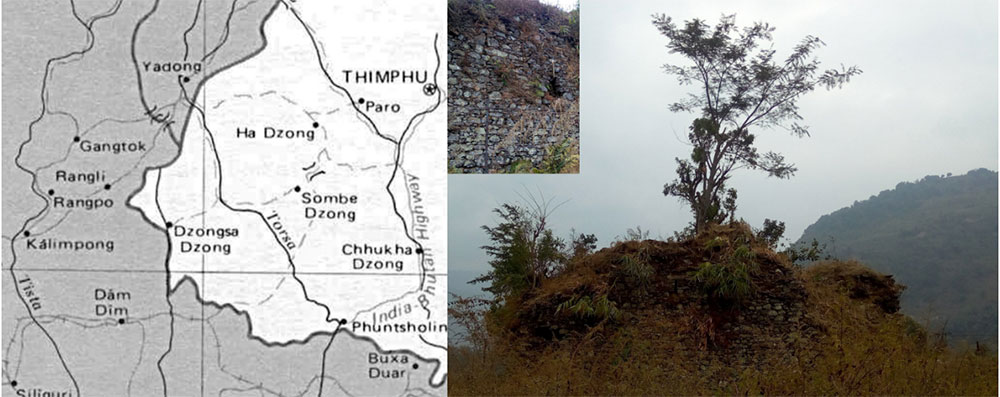History blurs with the mystery at a stunning cliff amongst the disappearing ruins of an ancient dzong located at Dzongsa commonly known as Jumsa, around 15 kilometres towards Tendu from Tashichhoeling (Sipsu) town in Samtse. The ruin is located about 80 meters away from the road. The name of the place, Jumsa, is a distorted derivation from Dzongsa. However, the roadside distance indicator gives back the original name to the place.
Some old maps indicate a dzong here, but one can afford to be sceptical until the unassuming ruin stands right in front of a visitor. Moreover, unlike the other famous towering ruined Dzongs, this ruin and the central tower is accelerating toward complete disappearance and can be easily mistaken for a heap of undergrowth locally known as amlisho, broom plant, and tithopati, Artemisia, during the rainy season. The remains of the random rubble masonry wall are further strangled by the roots of a tree that have flourished and tower over the ruins and it is only speculative to date the construction of the dzong. Some sources say that the Dzong was known as Damsang Dzong and it was built during Desi Tenzin Rabgye’s time but in the absence of any written records, it is difficult to get details on the history of the Dzong.
A closer visual survey of the ruins reveals stone wall foundations all around the five-meter-tall ruins which might have been the central tower of the dzong. Was it a complete dzong with courtyards and festivals or just a garrison or a place for tax collection in ancient times? No one knows for sure. Or was it a dzong connecting Sombe Dzong in Haa to Pedong and Kalimpong across the Jaldhaka River which was part of Bhutan before the 1865 Duar Wars?
The books on Ashley Eden who camped at Sipsu on his mission to Punakha don’t refer to any such structure.
The restoration of the dzong appeared in the manifesto of its first elected MP Durga Prasad Chettri during the 2008 elections and sadly it remained only on paper and the walls, and the ruins are waiting for local leaders, authorities, historians, and restoration experts to bring into the light the story of a dzong that once proudly stood at a visually thrilling cliff above the confluence of three rivers and above the Bindu barrage and the Jaldakha hydel project. Its restoration might give the Dzongsa Dzong and the ruins an appropriate place in the modern history of Bhutan and bring a sense of belonging and pride to the community and Dungkhang of Tashichoeling.
Only if the walls could speak, the stones in the disappearing Dzongsa Dzong ruins would have the original story to tell.
Contributed by Dhrubaraj Sharma
QUT Design Lab


